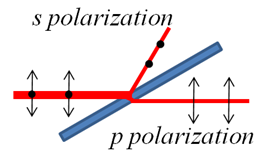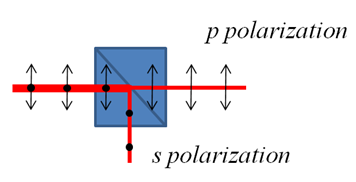In the optical experiment, Polarizer plays a very important role. In the field of traditional laser amplification, Polarizer can be used to form an optical isolation system with a Faraday rotator and can also be used to form an electro-optic switch of a solid-state laser with an electro-optic crystal. In the emerging field of pump detection, Polarizer can be used to detect the change of the polarization state of the signal light by the detected sample, and then carry out ultrafast dynamics research of magnetic materials, etc.
I. Difference of Polarizer
There are two types of Polarizer: absorption type and spectroscopic type [1]. Absorptive elements have little absorption of light in a certain polarization direction but have strong absorption of light perpendicular to the polarization direction, therefore the light passing through the element is a light of a single polarization direction. Spectroscopic elements are the most commonly used polarization selection elements, whose working principle is generally based on birefringence effect or polarization beam splitting film, commonly including Glan prism, thin film polarizer (TFP), and polarization beam splitter (PBS). The former is based on the birefringence effect, and the latter two are based on PBS films, which will be introduced one by one.
1. Glan prism
The Gran Prism consists of two identical right-angle prisms (materials are birefringent crystals such as calcite), as shown in the figure. The two prisms are glued together with an air gap in the middle. The optical axis of the crystalline material is parallel to the paper surface, and the polarization direction of the incident laser light is the e-ray (extraordinary ray) and the o-ray (ordinary ray) perpendicular to the optical axis. The refractive index of the two beams of light in the crystal is different. On the surface of the air gap, an o-ray produces total reflection (the incident angle is the Brewster angle of o-ray), and a small part of the e-ray also produces reflection. Most e-ray is projected through the air gap and then another part of the crystal is output. Tp/Ts> 1000:1

2. Thin film polarizer (TFP)
TFP is formed by coating a film system based on interference effects on a glass substrate. There are generally two types of Brewster angle placement and 45-degree placement. The former has little reflection of transmitted light, but due to the placement of the Brewster angle, if you use its reflected light, you generally need to use a pair of TFP to select the s-polarized light and adjust it to be parallel to the incident light. The latter is convenient to directly use the reflected s-polarized light (the incident angle of the conventional reflector is 45 degrees or 0 degrees). For a certain proportion of reflected light, it is necessary to plate an antireflection coating on the rear surface to improve the excessive rate of transmitted light, and the film design on the front surface is more complicated [2], the cost is higher than the TFP placed at Brewster angle.

3. Polarization beam splitter (PBS)
The principle of PBS is similar to that of TFP. It is formed by bonding two right-angle prisms, and the internal reflection surface is coated with a special film system to separate s polarization and p polarization.

II. Selection of Polarizer
In actual use, the extinction ratio of the Glan prism is relatively high, and the ratio of the transmittance to p-polarization and the transmittance to s-polarization Tp/Ts> 1000:1 is generally achieved. Meanwhile, it is generally used as a transmissive type (which will be a small part of the reflection, so the extinction ratio of the reflective type is not high); for TFP, it can be used as a transmissive or reflective type. In general, the extinction ratio of more than 200:1 can be achieved in both modes, being similar to PBS as well.
The TFP placed by the Granite prism and Brewster angle can work in a wide spectrum condition, which is convenient for the field of broadband femtosecond laser; while the TFP and PBS are placed at 45 degrees can only work in a narrow spectrum condition.
The damage threshold of the Gran Prism and TFP is relatively high. Using the 1064 nm nanosecond laser as the test, the damage threshold can reach more than 5 J/cm2; while the damage threshold of PBS is relatively low, which is 1 J/cm2. Due to the limited size of bulk materials, TFP is more suitable for use in high-energy laser systems with large beam diameters.
With the use of Glan prisms and TFP, due to the refraction effect, the transmitted light will have a translational amount relative to the incident light, and PBS will not have this problem. In addition, one should pay special attention when using TFP and PBS. When using TFP, there will be Ghost reflections, that is, due to the reflection of the rear surface, there is a parallel faint light next to the main beam (mainly this problem occurs when it is used in the reflection type). It is necessary to eliminate the influence of this beam; PBS will also have this problem, but the degree will be weaker.
References:
[1] https://en.wikipedia.org/wiki/Polarizer#Thin_film_polarizers
[2] https://www.rp-photonics.com/thin_film_polarizers.html?s=ak